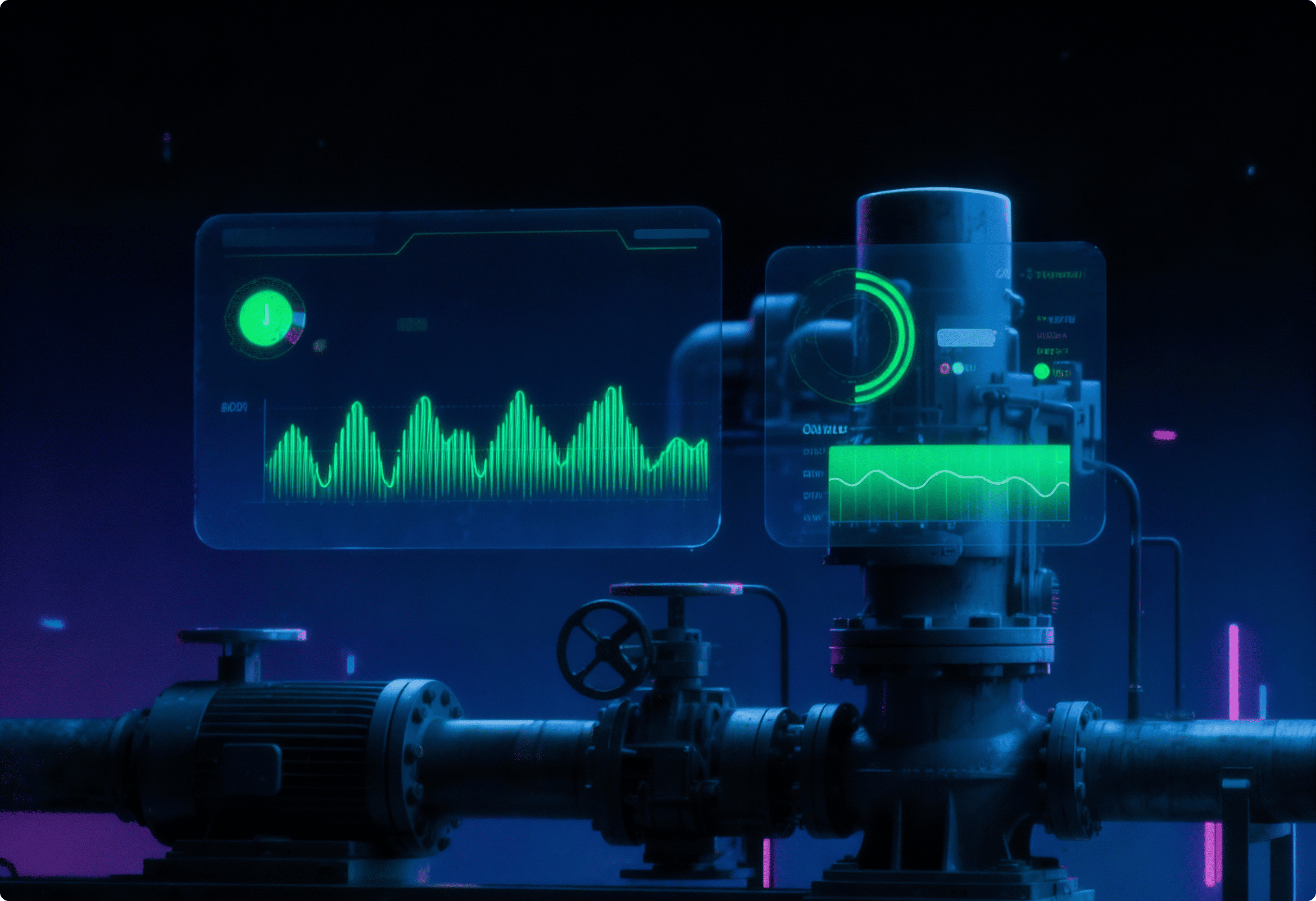Condition-Based Monitoring: Technologies and Best Practices 2026
How to implement real-time equipment monitoring systems, select the right parameters for vibration analysis and condition tracking, and integrate CBM strategies with existing CMMS platforms to reduce maintenance costs by 25-40% and extend asset life by 20-30%.

TL;DR
Condition-based monitoring shifts maintenance from fixed schedules to actual equipment health, triggering interventions only when needed. Leading implementations achieve 25-40% maintenance cost reductions, 35-50% fewer unplanned failures, and 20-30% longer component life. However, 47% of CBM projects fail due to monitoring the wrong parameters, setting ineffective thresholds, or poor integration with maintenance workflows.
Highlights
- Monitor vibration, temperature, and lubricant condition as primary indicators — these three parameters detect 75-90% of mechanical failures before they occur
- Set dynamic thresholds based on operating conditions rather than fixed limits — reduces false alarms by 60-80% while improving detection sensitivity
- Integrate CBM alerts directly into CMMS work order systems to achieve 70-85% maintenance team adoption versus standalone monitoring dashboards
Introduction
A paper mill in Finland replaced bearings on their main paper machine every 6,000 operating hours regardless of condition. Annual bearing replacement cost: €340,000 in parts and labor. They implemented condition-based monitoring tracking vibration and temperature continuously. First year results: bearings ran an average of 8,400 hours before CBM flagged replacement needs. Some reached 11,000 hours. Maintenance costs dropped to €215,000 annually while unplanned failures decreased by 68%.
Condition-based monitoring eliminates the guesswork in maintenance timing. Instead of replacing components based on calendar or runtime, you maintain based on actual deterioration. Equipment tells you when it needs attention through measurable changes in vibration patterns, temperature profiles, oil contamination, acoustic signatures, or electrical characteristics.
The business case is compelling. Aberdeen Group’s 2024 research shows manufacturers with mature CBM programs average 25-40% lower maintenance costs, 35-50% fewer emergency breakdowns, and 20-30% longer asset lifespans compared to time-based maintenance approaches. Yet implementation success rates remain problematic — Gartner found 47% of CBM initiatives launched in 2022-2023 failed to deliver expected returns.
Technology isn’t the barrier. Sensors are affordable and reliable. Analytics platforms are powerful. Networks are robust. Projects fail due to three implementation mistakes: monitoring parameters that don’t correlate with actual failures, setting alert thresholds that generate noise instead of insight, and building monitoring systems that operate separately from maintenance workflows.
This guide covers parameter selection by equipment type, threshold configuration strategies, and CMMS integration approaches based on implementations across chemical processing, power generation, and manufacturing facilities.
Parameter Selection by Equipment Type
Rotating equipment (motors, pumps, fans): Vibration analysis detects 80% of mechanical faults — bearing wear, misalignment, imbalance, looseness. Monitor velocity (mm/s RMS) and frequency spectrum. Add temperature monitoring for bearing housings and winding temperatures.
Gearboxes and transmissions: Vibration (focus on gear mesh frequencies), oil analysis (wear particles, viscosity), acoustic emission (crack detection). Temperature differential between input and output shafts indicates efficiency loss.
Hydraulic systems: Pressure fluctuations, flow rates, oil contamination (particle count), temperature. Filter differential pressure indicates contamination levels before system damage occurs.
Electrical equipment: Current signature analysis detects rotor bars, winding faults, load imbalances. Thermal imaging catches hot spots. Partial discharge monitoring for high-voltage equipment predicts insulation failures.
Dynamic Threshold Strategies
Traditional static thresholds fail because equipment operates under varying conditions. A conveyor motor at 20% load has different vibration signatures than at 80% load. Load-normalized thresholds adjust alarm limits based on current operating state.
Baseline establishment: Capture 30-90 days of data across all operating conditions. Calculate statistical baselines (mean, standard deviation) for each condition range. Set warning thresholds at 2 sigma, alarm at 3 sigma from baseline.
Adaptive thresholds: Automatically adjust limits as equipment ages or seasonal conditions change. A cooling tower in summer operates warmer than winter — thresholds should reflect this rather than triggering false alarms.
Contextual filtering: Suppress alarms during startup, shutdown, or known transient events. A pump starting draws high current briefly — this shouldn’t trigger alerts.
CMMS Integration Architecture
API-based integration: CBM platform sends alert data to CMMS via REST API. Automatically generates work orders with severity, recommended action, asset history, and relevant sensor trends attached. Maintenance planners see CBM priorities in normal workflow.
Bidirectional data flow: CMMS sends maintenance activity records back to CBM system. When bearing is replaced, CBM resets baseline for that asset. This closed-loop feedback improves future predictions.
Dashboard consolidation: Embed CBM widgets into CMMS dashboards rather than requiring separate login to monitoring tools. Maintenance teams work from single interface showing both scheduled work and condition-based priorities.
Condition-based maintenance is not about collecting more data — it’s about collecting the right data and acting on it intelligently. Monitor what matters, ignore what doesn’t.
— John D. Campbell, Founding Partner of Operational Excellence Consulting
Monitoring Parameter Comparison
| Parameter | Detects | Equipment Type | Cost |
| Vibration | Bearings, misalignment, imbalance | Rotating equipment | €200-1,500 |
| Temperature | Overheating, lubrication issues | Motors, bearings, electrical | €50-400 |
| Oil Analysis | Contamination, wear particles | Gearboxes, hydraulics | €80-250/test |
| Current Signature | Rotor bars, winding faults | Electric motors | €300-800 |
CBM Strategy Comparison
| Strategy | Monitoring Frequency | Best For | ROI Timeline |
| Continuous Online | Real-time (seconds) | Critical assets, high downtime cost | 6-12 months |
| Periodic Automated | Hourly/daily | Standard production equipment | 12-18 months |
| Route-Based Enhanced | Weekly with handheld tools | Non-critical, distributed assets | 18-24 months |
| Hybrid | Critical continuous, others periodic | Mixed criticality fleet | 8-14 months |
Real Implementation Case
Power Plant Turbine Monitoring

Challenge: Gas turbine downtime costs €180K per day. Monthly inspections missed developing issues. Needed continuous monitoring without overwhelming operations team.
Approach: Continuous vibration, temperature, performance monitoring. Edge analytics with adaptive thresholds. Only anomalies and degradation trends sent to operators — not raw data. CMMS integration for automatic maintenance scheduling.


Results: Detected blade fouling 8 days before performance impact. Caught bearing issue 11 days before failure. Enabled condition-based overhaul scheduling — extended intervals from 8,000 to 9,200 hours. Reduced false alarms by 73% versus previous system.
Key lesson: Edge processing with adaptive thresholds kept alert volume manageable — operators received 2-3 actionable alerts monthly versus 50+ with static thresholds.

12-Week CBM Deployment
Weeks 1-3: Asset Prioritization and Parameter Selection
Rank assets by downtime cost and failure frequency. Select top 15-25 for initial deployment. Identify failure modes for each asset — bearing failures, seal leaks, overheating. Match monitoring parameters to failure modes: vibration for mechanical issues, temperature for thermal problems, oil analysis for lubrication systems. Verify existing sensor infrastructure and determine gaps.
Weeks 4-5: Baseline Data Collection
Collect 30-60 days of continuous data across all operating conditions. Capture startup, shutdown, low load, high load, seasonal variations. Calculate statistical baselines — mean, standard deviation, percentiles. Document normal operating ranges for each condition state. This baseline is critical for setting effective thresholds later.
Weeks 6-7: Threshold Configuration
Set dynamic thresholds at 2 standard deviations (warning) and 3 standard deviations (alarm) from baseline. Configure contextual filters to suppress alarms during startups, shutdowns, and known transient events. Implement load-normalized thresholds that adjust based on current operating conditions. Test threshold sensitivity on historical failure data if available.
Weeks 8-9: CMMS Integration
Configure API connections between CBM platform and CMMS. Map CBM alert severities to work order priorities. Set up automatic work order generation including asset ID, alert type, sensor trends, and recommended actions. Establish bidirectional flow so maintenance activities update CBM system. Embed CBM dashboards into CMMS interface.
Weeks 10-11: Pilot Operation
Run CBM in parallel with existing maintenance program. Validate alert accuracy against known equipment conditions. Tune thresholds based on false positive rates — target under 10%. Gather feedback from maintenance team on alert actionability and CMMS workflow.
Week 12: Full Deployment and Training
Transition from pilot to production. Train maintenance planners on prioritizing CBM alerts versus scheduled work. Train technicians on interpreting sensor trends and alert context. Document response procedures for each alert type. Establish KPIs: alert response time, false alarm rate, prevented failures, maintenance cost trends.
Critical success factors: Start with assets where failure modes are well understood — don’t monitor everything hoping to discover insights. Invest heavily in baseline establishment — rushed baselines lead to poor thresholds and alert fatigue. Integrate with CMMS before full deployment — standalone systems see only 25-35% adoption.
Watch: Learn how modern sensor technologies are reshaping maintenance strategies through condition-based monitoring: Smarter Maintenance Leveraging Sensors for Condition-Based Monitoring.
Pitfalls and Best Practices
Monitoring too many parameters: A refinery instrumented compressors with 15 sensor types per unit hoping to catch everything. Data overload made pattern recognition impossible. They refined to 5 critical parameters — vibration, temperature, pressure, oil condition, performance — improving detection while reducing complexity.
Static thresholds across all conditions: Equipment behaves differently at varying loads and temperatures. A mining operation set fixed vibration limits causing 60+ false alarms weekly. Switching to load-normalized thresholds reduced false alarms by 78% while catching two legitimate issues previously masked by alarm fatigue.
Poor baseline quality: Rushed baseline collection during abnormal conditions creates unreliable thresholds. A pharmaceutical plant collected baseline during equipment commissioning — higher vibration than steady-state operation. Result: real degradation went undetected for months because thresholds were set too high.
Alert fatigue from excessive sensitivity: Overly aggressive thresholds generate constant alarms. Technicians learn to ignore them, missing critical events buried in noise. Target false alarm rate under 10%. One nuisance alarm weekly is acceptable; five daily destroys credibility.
No closed-loop feedback: CBM systems that don’t receive maintenance activity updates can’t learn. When bearings are replaced, the system should reset baselines. When alarms prove false, investigate why — sensor calibration drift, threshold misconfiguration, or legitimate transient events requiring contextual filters.
Standalone monitoring systems: CBM platforms operating separately from CMMS see 25-35% adoption. Maintenance teams won’t check multiple systems. API integration enabling automatic work order generation achieves 70-85% adoption — alerts appear in workflows teams already use daily.
Best practices: Version control threshold configurations as you tune them. Track which parameter combinations best predict specific failure modes. Implement alert escalation — warning alerts to technicians, critical alerts to supervisors with SMS/email. Build operator confidence through transparency — show trend data supporting alerts, not just binary alarm states. Establish quarterly threshold review cycles incorporating lessons from false alarms and missed detections.
Key Insights
- Parameter selection matters more than monitoring frequency. Focus on vibration, temperature, and oil condition for mechanical assets — these three detect 75-90% of failures. Avoid instrumenting everything; monitor parameters that correlate with actual failure modes.
- Dynamic thresholds eliminate alert fatigue. Load-normalized and adaptive thresholds reduce false alarms by 60-80% while improving sensitivity. Static limits generate noise that destroys maintenance team confidence in the system.
- CMMS integration drives adoption. CBM systems with automatic work order generation achieve 70-85% team adoption versus 25-35% for standalone dashboards. Integration determines whether insights translate to maintenance actions.
Related Resources
How to Choose a Web Development Company in the USA — and Why the Market Is Evolving Faster Than Ever
Learn how to pick a web partner who understands CMMS/EAM integration, CBM workflows, and long‑term operational support.
Digital Twins in Manufacturing: From Concept to Implementation
Understand how digital twins enhance equipment visibility and integrate with CMMS/EAM systems for smarter maintenance.
Enterprise Asset Management (EAM): Implementation Strategies
Explore key steps for selecting and deploying EAM systems, integrating with ERP, and measuring operational impact.
Conclusion
Condition-based monitoring delivers measurable results: 25-40% maintenance cost reduction, 35-50% fewer unplanned failures, 20-30% longer asset life. The technology works when implemented strategically.
Success requires three elements: monitoring parameters that actually predict failures, setting thresholds that signal genuine degradation without noise, and integrating alerts into maintenance workflows rather than creating parallel systems.
The CBM landscape in 2026 favors practical implementations. Sensor costs have dropped dramatically. Analytics platforms handle dynamic thresholds automatically. API integrations with major CMMS platforms are standardized.
Equipment failures cost too much to maintain by calendar or hope. The question isn’t whether to implement CBM — it’s whether you’ll deploy it on critical assets before competitors gain the efficiency advantage.